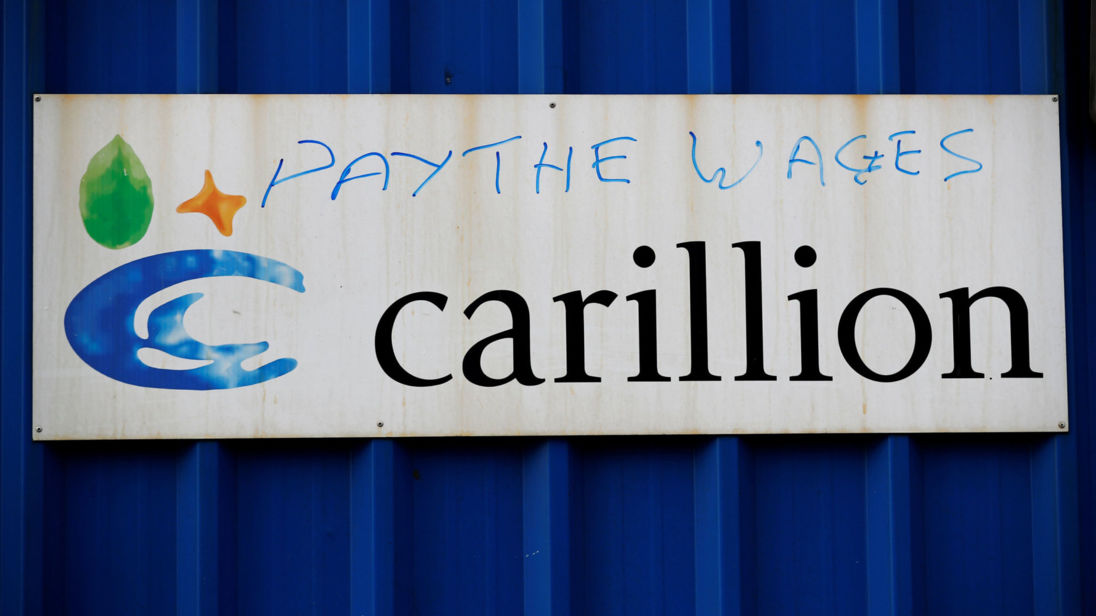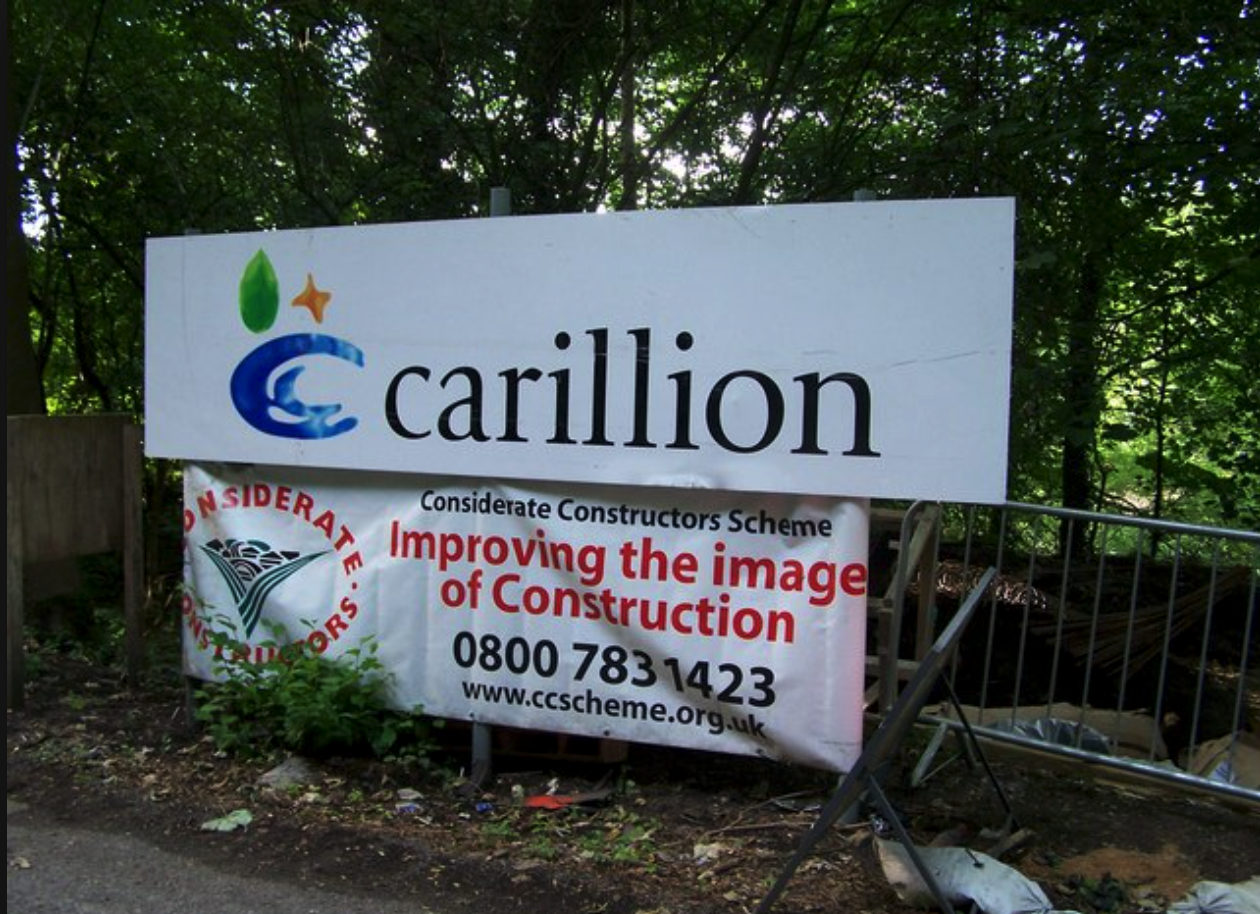
Defaced branding is seen outside Carillion’s Royal Liverpool Hospital site in Liverpool, Britain, January 16, 2018. REUTERS/Phil Noble
Global Pension Collapse Begins
Pension Crisis And Deficit of £2.6 Billion At Carillion To Impact UK Pensions
Pension Crisis And Deficit of £2.6B At Carillion To Impact UK Pensions
– Carillion collapses leaving a £900 million debt pile and 30,000 pensions at risk
– Carillion PLC share price has collapsed 94% in last twelve months
– Private analysis of Carillion’s pension deficit reveals it to be as high as £2.6 billion
– Figure adds to the UK’s ongoing pension crisis, both private and state are severely underfunded
– UK’s Private Pension Fund already has a levy of £550 million for next twelve months
– UK state pension crisis as state fund to be ‘exhausted by 2033’
– Ensure your pension is funded and properly diversified with gold
Editor: Mark O’Byrne
The looming pension crisis has been signalled in the collapse of Carillion. The deficit of latest private sector dead-on-arrival Carillion is officially £580 million. However, private reports suggest it could be as high as £2.6 BILLION.
According to a Sky News investigation: ‘the £2.6 billion figure relates to the cost to Carillion of paying an insurance company to guarantee all of its pension liabilities, and is significant because it is likely to be the sum claimed on behalf of the pension schemes as part of the liquidation process.’
Nearly 30,000 UK workers’ pensions are at risk thanks to Carillion management’s total mismanagement of a company that has seen its share price collapse 94% in the last 12 months.
Carillion’s 27,500-member pension scheme was placed on an ‘at risk list’ in autumn 2017. Arguably, it like many other pension funds should have been there many months ago.
Sadly, Carillion is just the latest in a very long string of serious company collapses that have highlighted the major pension crisis in the UK and around the Western world. It also likely signals that we may be on the verge of many, many more very large corporate bankruptcies in the UK due to massive debt levels and unfunded liabilities.
This is not a situation unique to the private sector. It will be repeated in the years ahead – both in the public and the private sector.
In November 2017, the OECD warned that the UK’s defined benefit workplace pension plans (final salary schemes) as ‘persistently underfunded’ and the state pension as seriously lacking.
Everyone is exposed by this and it emphasises the importance of saving for retirement and ensuring your pension is both funded and properly diversified.
These ongoing disasters in the UK’s pension pots are also a threat to the efforts of prudent individuals who have worked hard to set aside enough for their hard-earned retirements.
Private Pension Fund Palaver
The UK’s Private Pension Fund estimates that it will cost around £900m to cover the costs of the Carillion pension schemes. The idea of the PPF is that it is funded by liquid private companies who offer private pensions, as a sort of insurance should a Carillion-esque disaster strike.
The PPF rescue of Carillion pensioners is not a full-blown well-equipped life boat rescue, it’s more of a rubber dinghy and a metallic blanket. The rescue fund will pay current Carillion pensioners lower cost-of-living increases than they have been used to, and slash the eventual payments of those who aren’t yet retired.
The Telegraph explains the current state of the PPF:
As of March 2017, the PPF had £28.7bn in invested assets, and cash reserves of £6.1bn. It has a funding ratio – the fund’s assets versus its liabilities – of 121pc. The PPF is the backstop for final salary schemes, which pay guaranteed, inflation-proofed pensions for life.
At the moment (without the Carillion liability) the levy from the PPF is £550m. With this new expense companies who have their own defined-benefit schemes (and therefore must pay into the fund) will see their reviews increase. What damage will this do to the wider economy? How sustainable is a fund that is designed purely to rescue unfunded and bankrupt pension funds?
Why, if you are having to effectively-bailout the pension schemes of your failed contemporaries? Are you at all incentivised to invest in your own company, put up wages or even increase pension contributions yourself? It’s not as though the PPF is filling its contributors with confidence that levies are going to go down any time soon.
The failure of Carillion is a stark reminder that more often than not institutional shareholders, management board members and (in this specific case) politicians act in their own interest, frequently short term, rather than stopping to think what the overall, long term impact of their actions will be.
Reports state that Carillion over 2015 and 2016, £162 million has paid dividends to shareholders, compared with just £94 million to address the pension deficit.
The UK’s pension crisis
Last year we brought you the news that a Pensions and Lifetime Savings Association report found that three million workers with final salary pensions have 50% chance of losing up to fifth of their income because their employers have made unaffordable promises.
We outlined:
The PLSA data finds the most vulnerable employers have a 50:50 chance of not having an insolvency event in the next 30 years:
“More than 11 million people rely on defined benefit pension schemes for some or all of their retirement income but there is a real possibility that without change we will see more high profile company failures such as BHS or Tata Steel.”
Former pensions minister Steve Webb told City A.M. that he agrees:
“It’s not enough money. It’s just brutally not enough money going in,”
Just this week FCA Chief Executive Andrew Bailey made a point of the dangers looming for retirees, in his annual Mansion House speech:
“There is a clear risk that the savings rate for retirement is for many people too low to meet their expectations of retirement.”
The Carillion debacle will just add to this drama. The Private Pension Fund will once again have to step in and cover the expenses of the company’s 13 pension schemes.
Of course, at the moment all of the headlines are all about Carillion’s pension disaster. But what about the hundreds of sub-contracting firms who have their own schemes to cover? And are no longer going to be paid?
The ripple effect of the downfall of this firm will be far and wide. Yet again the mismanagement by the few will end up having an effect on the many. The pension crisis disaster could leave multiple pension pots unfunded and thousands of people bankrupt.
Private pensions are not alone
Many Brits and Europeans have more than one pension and this includes the state pension. For those in the United Kingdom, this is sadly also under threat.
Back in December, we brought you news of a report from the OECD that found those Brits planning to rely solely on their state pension will be left ‘with few resources.’ So bad is the situation that the body felt the need to remind politicians of the importance of long-term planning over short-term policy gains.
Inevitably, it is the tax payer who ends up forking out for government mistakes when it comes to misspending. Earlier this month the Government Actuary Department (GAD) said the rate of National Insurance (the manner in which Brits contribute to state pensions) may have to increase by as much as 5% in order to maintain the stability of the state pension fund.
This is bad news for both worker and employer. Estimates suggest this increase could add an additional £120 and £138, respectively in contributions from each party.
Furthermore, the lack of money means more time is required to have enough for retirees, therefore there is a suggestion that the retirement age is increased once again. This would be a measure to avoid increasing taxes.
GAD warned:
‘There won’t be enough coming in from National Insurance to cover the cost of paying the state pension…
‘To stop that happening, NI contributions have to go up or the government will have to make changes to the state pension or the age it is paid from.’
However, even with this and recently announced changes to minimum pension contributions the Department of Work and Pensions estimate 38% of the UK workforce are under-saving for retirement.
So for those who are saving and working, this is no doubt yet another cost that will come back to bite you no matter how responsible you have been with your own pension pot.
When it comes to your pension, beware who you trust
It is vital that savers and investors begin to take responsibility for their own pensions and ask questions. Most importantly one must ask if you can hold gold as part of your pension.
Gold should be a key part of your pension portfolio. At the moment UK pensions are at threat not just because of Carillion-esque disasters or bad planning by governments, but indirectly due to likely being used to bail-out pension pot implosions. Gold cannot be taken by governments or banks looking to top up their coffers.
The economy shows that whilst stock and bond markets have done well in the short term, they are artificially overvalued. Once again this is with thanks to the easy monetary policies of central banks and governments. So whilst readers may think they are in well-funded pension pots, or have some level of protection, where is the real value coming from?
Gold will protect in coming pension crisis
This is where gold plays a key role.
Dr. Constantin Gurdgiev, formerly an adviser to GoldCore, says the following about the importance of having gold in your pension:
“Gold is a long-term risk management asset, not a speculative one.
As such it should be analysed and treated predominantly in the context of its role as a part of a properly structured, risk-balanced and diversified portfolio spanning the full life-cycle of the investment and pension horizon for individual investors and those with pensions.
Whether they be SIPPs in the UK or IRAs in the USA.”
Investors in the UK and Ireland, the US, the EU can invest in gold bullion in their pension, through self-administered pension funds.
UK investors can invest in gold bullion through their Self-Invested Personal Pensions (SIPPs), Irish investors can invest in gold in Small Self Administered Schemes (SSAS) and US investors can invest in gold in their Individual Retirement Accounts (IRAs).
The pension crisis is a multi-trillion pound crisis. It is not going to go away. Adding physical gold to your pension is a key way to protect your retirement from the pensions time bomb.
As is owning physical gold outside a pension fund and as a hedge and safe haven, store of value.
Pension funds, throughout the West, have a distinct lack of diversification when it comes to assets. This has cost pension holders a huge amount of money and places their future viability at risk.
Gold bullion has an important role to play over the long term in preserving and growing pension wealth. Read our guide about how to own gold in a pension (CGT free) in the UK here.
